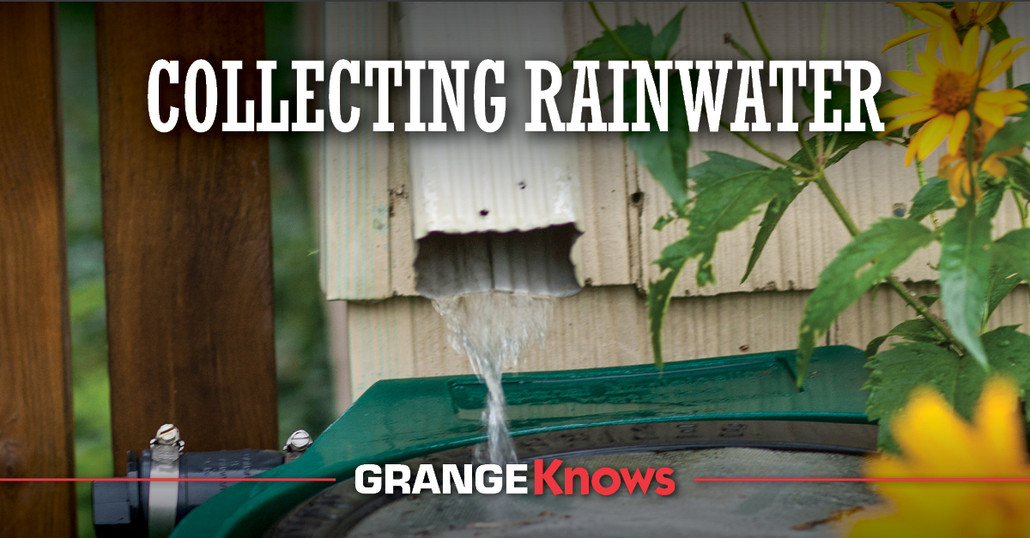
Collecting Rainwater
Posted by Grange Co-op on 11th Feb 2025
Water is one of the most vital resources for maintaining a thriving farm or garden. While irrigation systems and municipal water supplies are common solutions, there’s a cost-effective and eco-friendly alternative that often goes overlooked: rainwater harvesting. Collecting rainwater is not only good for your wallet but also beneficial for the environment and your plants.
In this blog, we’ll dive into the benefits of rainwater collection, how to set up your system, and tips to maximize its efficiency. Whether you’re a seasoned homesteader or a casual gardener, this guide will inspire you to make the most of what nature provides.
Why Collect Rainwater?
Rainwater harvesting has been practiced for centuries, and for good reason. Here’s why you should consider it:
- Cost Savings
Using harvested rainwater can reduce your reliance on municipal water, lowering your water bill. Over time, the savings can offset the initial setup costs of a collection system. - Eco-Friendly
Collecting rainwater reduces runoff that can carry pollutants into local waterways. It’s a sustainable practice that helps conserve water resources, especially in areas prone to drought. - Better for Plants
Rainwater is naturally soft and free from chemicals like chlorine and fluoride, which are commonly found in tap water. This makes it ideal for watering plants, as it promotes healthier growth. - Emergency Preparedness
Having a reserve of rainwater can be invaluable during dry spells, water restrictions, or emergencies.
How Rainwater Collection Works
At its core, rainwater harvesting is simple: you collect water that falls on your roof or other surfaces and store it for future use. Here's an overview of the process:
- Catchment Area
The most common catchment area is your roof. Rainwater flows from the roof into gutters. Metal, tile, and slate roofs are ideal; avoid roofs treated with toxic chemicals or made of asbestos. - Gutters and Downspouts
These direct rainwater from your roof to your storage system. Ensure they’re clean and in good condition to prevent blockages or contamination. - Filtration
A basic filtration system removes debris, leaves, and sediment from the water before it enters your tank. - Storage Tank
Water is stored in barrels, cisterns, or larger tanks. Choose a material and size based on your needs—plastic, metal, or concrete are common options. - Distribution System
A hose or pump allows you to use the stored water for irrigation, cleaning, or other purposes.
Setting Up a Rainwater Collection System
Setting up a rainwater collection system can range from a simple DIY project to a more advanced setup for larger needs.
Step 1: Choose Your Collection Method
- Rain Barrels: Perfect for small gardens or urban settings, rain barrels are easy to install and affordable. Position them under downspouts and use them to water plants.
- Larger Cisterns: For farms or larger gardens, invest in a cistern, large tank, or underground storage container. These hold significantly more water and can supply irrigation systems.
Step 2: Install Gutters and Downspouts
Ensure your roof has gutters that channel water to downspouts. Clean them regularly to remove debris and improve water flow.
Step 3: Add a Diverter and Filter
Install a diverter to redirect the first flush of rainwater (which may carry dirt and debris) away from your storage tank. Add a filter to trap larger particles.
Step 4: Position Your Storage Tank
Place your tank on a level surface near the catchment area. Use gravity to your advantage by positioning the tank higher than the area you’ll water, or install a pump for convenience.
Step 5: Distribute the Water
Attach a spigot, hose, or drip irrigation system to make using the water easy and efficient.
How to Use Harvested Rainwater
Rainwater has a variety of uses for your farm or garden:
- Irrigation: Use rainwater to water your vegetables, flowers, and lawns.
- Livestock: Provide untreated rainwater to animals, ensuring tanks are clean and free of contaminants.
- Cleaning: Wash garden tools, equipment, or outdoor surfaces with harvested rainwater.
- Composting: Add moisture to your compost pile using rainwater.
Tips for Maximizing Efficiency
- Install a Screen or Mesh
Prevent leaves, insects, and debris from entering your collection system by adding a screen or mesh to gutters and tanks. - Use a First-Flush Diverter
This device discards the initial runoff from your roof, which is often the most contaminated. - Regular Maintenance
Clean your gutters, downspouts, and tanks regularly to ensure water quality. Check for leaks or cracks in the system. - Choose the Right Tank Size
Calculate your water needs based on garden size, local rainfall, and intended usage. Oversized tanks are great for farms, while smaller barrels work well for home gardens. - Optimize Water Distribution
Use drip irrigation or soaker hoses to distribute rainwater efficiently, reducing waste.
Legal Considerations
Before starting, check local laws and regulations regarding rainwater harvesting. While it’s encouraged in many areas, some states have restrictions on how much water you can collect or how it can be used.
Is Collecting Rainwater Worth It?
Absolutely! Collecting rainwater is a cost-effective and sustainable way to support your garden or farm. It’s easy to set up, versatile, and has long-term benefits for your plants and the environment. With proper planning and maintenance, a rainwater collection system can become an integral part of your homestead.
Visit Your Local Farm and Garden Store
Ready to start collecting rainwater? At Grange Co-op, we have everything you need—from rain barrels to irrigation systems and tools. Stop by your local store or visit our website for expert advice and high-quality products.
Let’s work together to create a sustainable future, one drop at a time!
